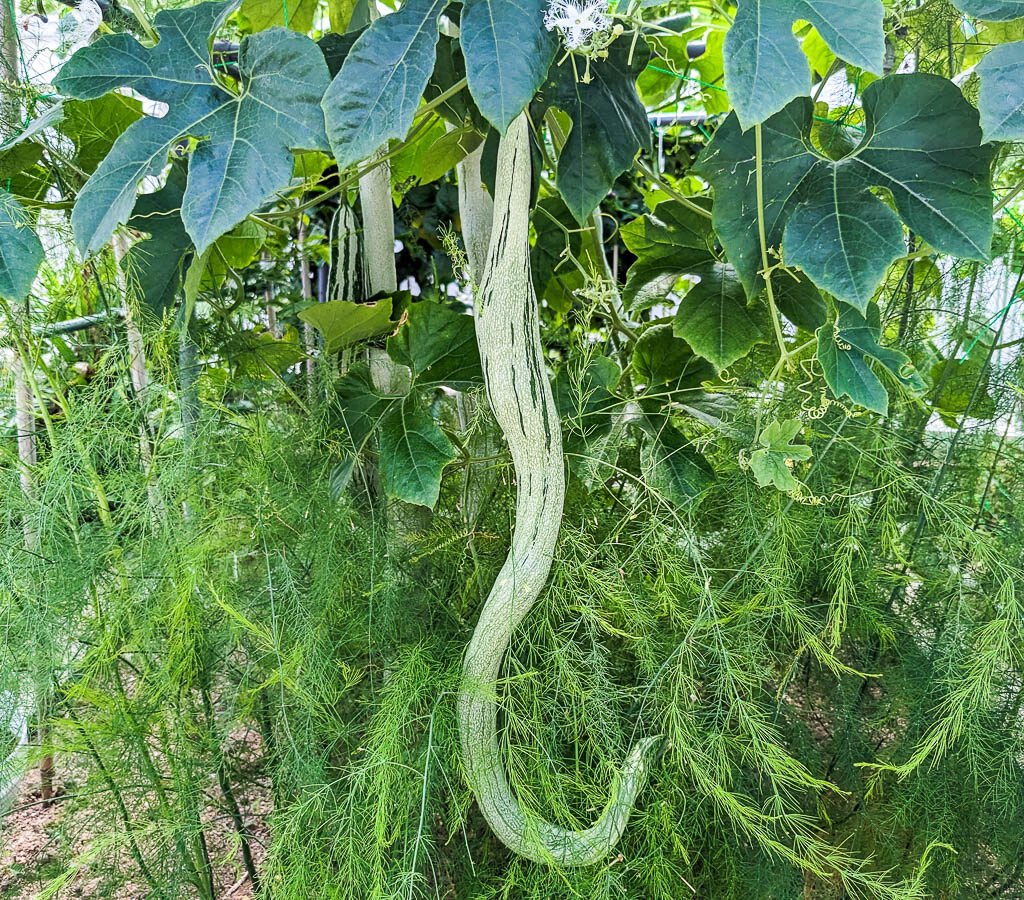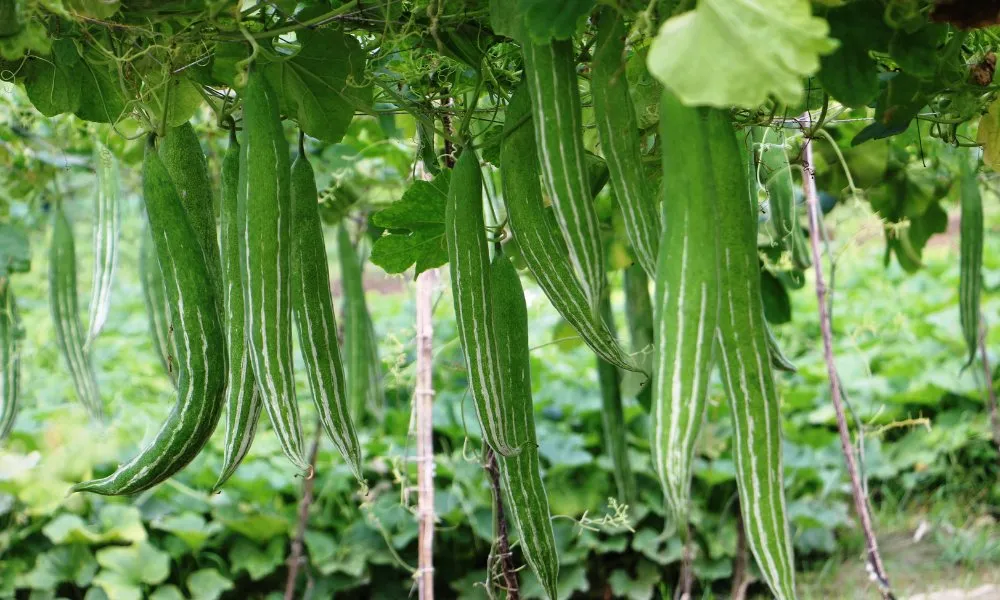When it comes to exotic vegetables making their way into American kitchens, snake gourd is slowly slithering into the spotlight. With its long, curling shape and crisp, mildly flavored flesh, this tropical vegetable is as fascinating as it is nutritious.
Traditionally popular in Indian and Southeast Asian cuisines, snake gourd is now gaining attention among American gardeners, chefs, and health enthusiasts for its incredible health benefits, versatility in cooking, and suitability for warm climates. Whether you want to grow it in your backyard or add it to your low-calorie meal plan, snake gourd deserves a place on your table.
In this comprehensive guide, we’ll explore everything you need to know about this unique vegetable — from its origins and nutritional power to its cultivation, health benefits, and tasty American-style recipes.
What Is Snake Gourd?

Snake gourd (Trichosanthes cucumerina) is a tropical vine vegetable belonging to the cucumber and gourd family. Native to South and Southeast Asia, it’s named for its striking resemblance to a snake — long, slender, and slightly curled.
The young fruit is tender and edible, while mature gourds become fibrous and are often used for seeds or natural sponges. In India, it’s commonly called “padwal” or “chichinda,” but in America, it’s affectionately known as snake gourd or serpent gourd.
Its mild, slightly sweet flavor makes it a versatile ingredient that can be used in stir-fries, soups, curries, and even stuffed dishes — similar to zucchini or cucumber but with its own distinct texture and aroma.
Nutritional Value of Snake Gourd
Snake gourd is a nutrient-dense, low-calorie vegetable packed with vitamins, minerals, and fiber. One cup (100 grams) of cooked snake gourd typically contains:
- Calories: 20
- Carbohydrates: 4 grams
- Protein: 1 gram
- Fiber: 1.2 grams
- Fat: 0.1 grams
- Vitamin A: 15% of the Daily Value (DV)
- Vitamin C: 20% of the DV
- Calcium: 4% of the DV
- Iron: 5% of the DV
- Magnesium and Potassium: small but essential amounts
Because it’s high in water and low in calories, snake gourd is ideal for hydration, digestion, and maintaining a healthy weight — making it a great addition to American health-conscious diets.
Health Benefits of Snake Gourd

Snake gourd isn’t just another exotic vegetable — it’s a true superfood loaded with healing properties. Here are some of its top health benefits:
1. Promotes Digestive Health
Snake gourd is rich in dietary fiber and water, helping to regulate bowel movements and prevent constipation. It also has mild laxative properties, which naturally support a healthy digestive tract.
2. Supports Weight Loss
Low in calories and fat but high in fiber, snake gourd fills you up without weighing you down. It’s a perfect vegetable for Americans following low-carb, keto, or clean-eating meal plans.
3. Helps Control Blood Sugar
Snake gourd may assist in stabilizing blood sugar levels thanks to compounds that enhance insulin function. That’s why it’s often recommended for people managing diabetes or prediabetes naturally.
4. Boosts Immunity
Loaded with vitamin C, snake gourd helps strengthen your immune system, protect against infections, and fight free radicals that cause cell damage.
5. Improves Heart Health
The potassium and magnesium in snake gourd contribute to healthy blood pressure levels and overall cardiovascular wellness. Its fiber also helps lower LDL (bad cholesterol).
6. Detoxifies the Body
Snake gourd acts as a natural detoxifier, cleansing the liver and kidneys. It’s also mildly diuretic, helping flush out toxins and excess fluids from the body.
7. Promotes Skin and Hair Health
With its high water content and antioxidants, snake gourd supports glowing skin and strong hair. It hydrates from within and may reduce acne and inflammation when included regularly in your diet.
Types of Snake Gourd

There are two main types of snake gourd commonly seen in markets and gardens:
1. Short Varieties
- About 1–2 feet long
- Thicker, with a straighter shape
- Ideal for cooking and home gardens
2. Long Varieties
- Can grow up to 4–6 feet long!
- Curly and slender with tender skin
- Used for stir-fries and soups
Both varieties are equally nutritious and can be used interchangeably in recipes.
How to Grow Snake Gourd in America
Good news for American gardeners — snake gourd grows exceptionally well in warm, sunny climates like Florida, Texas, California, and the southern states. It can even be cultivated in northern regions during the summer months.
1. Climate and Soil Requirements
- Snake gourd thrives in warm weather (75°F–90°F).
- Prefers loamy, well-drained soil rich in organic matter.
- Ideal pH: 6.0 to 7.0.
2. Planting
- Start seeds indoors 3–4 weeks before the last frost.
- Transplant seedlings outdoors after temperatures stabilize above 70°F.
- Space plants 3–4 feet apart and provide a trellis or fence for support.
3. Watering
- Keep the soil moist but not soggy.
- Water deeply 2–3 times a week during dry periods.
4. Fertilizing
- Use a balanced organic fertilizer or compost once every 2–3 weeks.
- Avoid excessive nitrogen to prevent leafy growth without fruits.
5. Harvesting
- Harvest when the gourds are 12–18 inches long and still tender.
- Overripe gourds become fibrous and less flavorful.
With proper care, snake gourd vines can yield a generous harvest throughout the summer — making it one of the most rewarding exotic vegetables to grow in the U.S.
How to Prepare and Cook Snake Gourd

Snake gourd’s subtle taste and crisp texture make it adaptable to many American and Asian-inspired dishes. Here’s how to prepare it:
Preparation Steps
- Wash the gourd thoroughly under running water.
- Peel lightly if the skin is thick (young gourds can be left unpeeled).
- Cut lengthwise and remove any mature seeds.
- Slice into rings, cubes, or strips depending on your recipe.
Delicious Snake Gourd Recipes
1. Snake Gourd Stir-Fry (American-Asian Fusion)
A light and flavorful side dish that pairs well with grilled chicken or rice bowls.
Ingredients:
- 2 cups sliced snake gourd
- 1 onion, thinly sliced
- 2 cloves garlic, minced
- 1 tbsp olive oil
- Salt, pepper, and soy sauce to taste
Instructions:
- Heat oil in a pan and sauté garlic and onions until golden.
- Add snake gourd and stir-fry for 5–6 minutes.
- Season with soy sauce, salt, and pepper. Serve warm.
2. Snake Gourd Soup
A refreshing, hydrating soup perfect for hot American summers.
Ingredients:
- 1 cup chopped snake gourd
- 1 small carrot, diced
- 3 cups vegetable broth
- 1 garlic clove, minced
- Salt, black pepper, and lemon juice to taste
Instructions:
- Bring broth to a boil and add all vegetables.
- Simmer until tender.
- Season and finish with lemon juice.
3. Stuffed Snake Gourd
A hearty, healthy dinner dish inspired by Mediterranean stuffed zucchini.
Ingredients:
- 2 medium snake gourds (cut into 3-inch segments)
- 1/2 cup cooked quinoa or brown rice
- 1/4 cup chopped bell peppers
- 1/4 cup feta cheese or tofu
- Olive oil, salt, herbs, and spices
Instructions:
- Scoop out the inner pulp of each segment.
- Mix filling ingredients and stuff into the gourds.
- Bake at 375°F for 20–25 minutes until tender.
Snake Gourd Juice for Detox and Weight Loss
Snake gourd juice is gaining popularity in the U.S. wellness community for its detoxifying properties.
How to Make It:
- Blend 1 cup of chopped snake gourd with ½ cup of water.
- Add lemon juice and a pinch of salt.
- Strain and drink chilled.
This refreshing juice is perfect for hydration, liver detox, and boosting metabolism — especially on a hot day or after a workout.
Storage Tips
To keep your snake gourd fresh:
- Store it in the refrigerator’s crisper drawer, wrapped in a paper towel or breathable bag.
- It stays fresh for up to 5–6 days.
- Avoid storing near ethylene-producing fruits like bananas or apples.
Fun Facts About Snake Gourd

- The plant gets its name because the long fruits often curl and hang like snakes from the vine.
- In traditional Indian medicine, snake gourd is used to treat fevers, liver issues, and inflammation.
- It’s sometimes called “vegetable serpent” due to its distinctive shape.
- In warm American states, snake gourd flowers bloom at night and attract moths for pollination.
Snake Gourd vs. Other Gourds
| Vegetable | Calories (per 100g) | Key Nutrient | Texture | Flavor |
|---|---|---|---|---|
| Snake Gourd | 20 | Vitamin C | Crisp, tender | Mildly sweet |
| Bottle Gourd | 15 | Folate | Soft | Mild |
| Bitter Melon | 19 | Vitamin A | Firm | Bitter |
| Zucchini | 21 | Potassium | Tender | Sweet, soft |
Snake gourd offers a unique balance — light like zucchini but more exotic in appearance and nutrition.
Conclusion: Why Snake Gourd Deserves a Spot in American Kitchens
As more Americans embrace global flavors and nutrient-rich produce, snake gourd stands out as an incredible addition to the modern diet. It’s light, hydrating, and packed with health benefits — from digestion and detox to heart health and immunity.
Whether you sauté it for dinner, sip it as juice, or grow it in your backyard garden, snake gourd offers freshness, versatility, and nutrition in one elegant package.
So, the next time you visit your local farmers’ market or try a new vegetable in your garden, give snake gourd a chance. You might just discover your new favorite healthy ingredient — one that’s as exotic as it is wholesome.






Leave A Comment